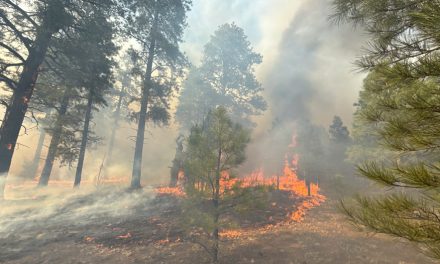
NAPI: Drought not a problem, but other concerns exist
WINDOW ROCK
For Navajo Agricultural Products Inc., the ongoing drought isn’t the issue. Rather it’s fending off prairie dogs, finding workers and dealing with aging infrastructure.
The Navajo Nation is still in an extreme and extensive drought. The area where NAPI’s production is located shows similar drought severity, according to the drought monitor website.
Although the drought is a concern, it hasn’t caused problems yet.
“NAPI is doing well in spite of the weather conditions,” said NAPI’s CEO, Dave Zeller. “Unofficially, the operations showed a $5.5 million net profit. Our revenues were $2.9 million more than budgeted. We are looking at a gross margin for last year of 15 percent, which is what we were hoping for.”
Zeller said $900,000 was paid in bonuses to essential workers during the pandemic. They also paid $1.36 million in profit sharing to employees and made a $1 million dividend payment to the Navajo Nation.
“NAPI, we are looking at $139 million in total assets we are responsible for,” Zeller said. “NAPI is strong. We are thriving.”
There is more than a sufficient amount of water in NAPI’s reservoir, which comes from Navajo Lake, he said, and they will have more than enough water for crop operations.
“We know that not everyone is as fortunate with their water activities in the lakes and other areas,” Zeller said. “But the Navajo Lake projections are more than adequate right now to get us through this particular crop year.”
In June, NAPI had almost 20,000 acres in alfalfa grass and 1,800 acres of hay grazer. NAPI had also set aside 1,025 tons of hay for the Navajo Department of Agriculture and the Navajo-owned Colorado ranches, Boyer and Wolf Springs, which still owes NAPI $21,297.
Six thousand acres of beans were planted, 18,000 acres of corn and more than 5,000 acres of wheat that should be ready for harvest early this month. Also planted are squash, zucchini, and potatoes, which got NAPI recognition as Supplier of the Year from Whole Foods.
Native foods include white, yellow and blue corn. Sumac and Navajo Tea were being harvested in June. Green chili, apple orchards and watermelon are growing.
“We are getting recognition from NAPI throughout the United States,” Zeller said. ”With this comes concerns … mainly the aging infrastructure.”
Earlier in the year NAPI had a water-line break, and the pipe that had to be fixed was an example of the aged infrastructure because the pipe was over 40 years old. Another water pump broke down, costing $610,000 to replace.
A main concern for NAPI is infrastructure breaking at the crucial time of planting.
Another issue is prairie dogs. For small rodents, they do millions of dollars of damage to crops. They also eat through lines, conduits, disrupt power lines and create holes in the field and burrows with mounds.
“In the alfalfa field it’s a problem,” Zeller said. “If the mowers don’t entirely miss the mound, it dulls the blades on the cutters. You have to be careful of that effect on the wheels of various equipment.”
Earlier this month, NAPI officials provided a tour of the Navajo Indian Irrigation Project for Sen. Ben Ray Luján, D-N.M., Vice President Myron Lizer, members of the Navajo Nation Council, and Navajo Nation Washington Office Executive Director Santee Lewis.
During the visit, they discussed initiatives and funding shortfalls that continue to impact the current condition of the NIIP, which is federally owned and operated and maintained by NAPI through a Public Law 93-638 federal contract with the Bureau of Indian Affairs.
NIIP’s purpose includes delivering water to approximately 110,630 acres of the Nation’s farm land.
Zeller and Lionel Haskie, operations and maintenance manager, highlighted the need for operations, maintenance and replacement funding to sustain NIIP.
Many of the pumping plants, substations and conveyance systems built prior to 1985 are now reaching the end of their service life, said Haskie.
Constant repairs and unplanned outages have increased because of the deterioration and aging equipment.
Through the Water Infrastructure Improvement for the Nation Act, 17 federally owned Indian irrigation projects are eligible to receive a fraction of $10 million per year for deferred maintenance and replacement costs.
NIIP is awarded $2.3 million per year to address deferred maintenance. The Navajo Nation and NAPI have requested to increase the amount to $35 million in fiscal 2022 so NIIP can receive a larger amount of WIIN Act dollars.
The BIA completed an inventory of the NIIP system in 2016 and identified over $174 million of remediation costs. A $35 million annual amount appropriated under WIIN would be needed to fund the high capital replacement cost.
Another concern is hiring enough employees. There are about 300 employees at NAPI currently and getting enough to meet needs is an issue.
It’s not only seasonal workers, in terms of farmers, but also engineers, electricians, welders and truck drivers.
“I realize farming isn’t a glamorous occupation and sometimes it can be difficult,” Zeller said. “It’s been a difficult time planting and I don’t think it will get any easier when we get into the fall with harvesting those crops.”










 Highway 264,
Highway 264, I-40, WB @ Winslow
I-40, WB @ Winslow